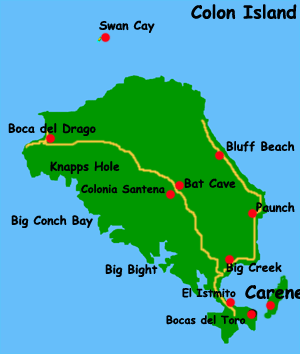

Boca del Drago is where Christopher Columbus actually first stopped in Panama as he sailed south from Costa Rica. He entered Admiral Bay (or Caribaro by the indians) via the channel that separates the mainland from Colon Island. You can get to Boca del Drago Beach from Bocas del Toro town, either by boat or via the track across Isla Colon.
By boat you travel along the south coast of Colon Island reaching the beach at Boca del Drago in about 30 minutes. If the sea is calm the boat can return by the open sea side of Colon Island, offering a magnificent view of a coast.
By road, public transport exists, or you can ride a bike there or take a taxi from Bocas town.. It is a a 25-minute trip by car,
Once you reach Boca del Drago you can enjoy beautiful beaches, walk among the trees or snorkel in the nearby coral reef. Boca del Drago is one of the best beaches on the island. However the surf can be rough at times. Yarisnori beach restaurant offers good seafood, cooked in the regional style. There are also some cabines available for lodging and several private houses that are used during the weekends.
In the waters just off the beach, a coral andsand sea bottom offers easy, shallow snorkeling when the sea is calm. Off Punta Rancho, accessible by boat to the south, large brain-coral heads make shelters for a large variety of tropical fish. Water visibility in the area ranges between 20-70ft, depending on weather conditions and time of year; the months between August-October tend to be the calmest.
Around 300 ngobe indians inhabit 25 houses along the road between Bocas del Toro and Boca del Drago.Boca del Drago itself has a primary school , with 2 classrooms, 2 teachers and some 45 students. They don't have electricity and the water comes from a creek. The indians are mainly fishermen, who also do a little farming.
The Bocas del Toro Biological Station has a facility here . This field facility is located on the beach between tropical rain forest and coral reefs. Terrestrial habitats include primary and secondary forests, marshes, swamps, streams, pastures and low impact beaches. Marine habitats include mangrove forests, turtle grass beds, coral reefs, and estuaries. Additional habitats accessible from the station include lakes and ponds, Limestone caves, rocky inter-tidal zones and high impact beaches.